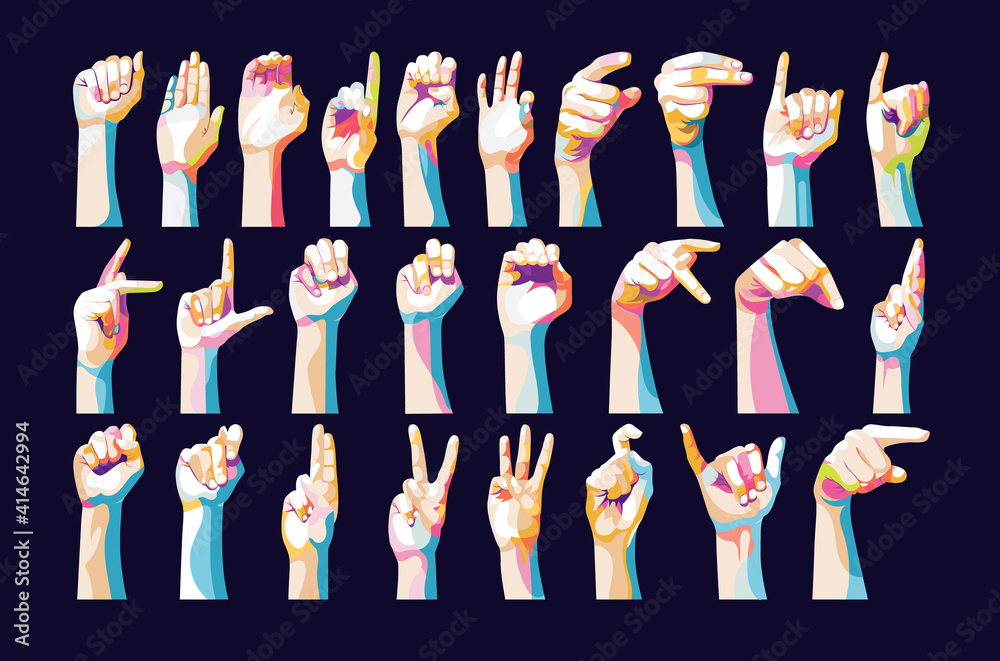🎙ASL Level 2, Activity 11-Conversations (Online)

Description:
Students will watch the lab instructor fingerspell words and apply their receptive skills and knowledge of vocabulary. Then students will sign and answer questions for the whole group.
Products: Fingerspelling, personal information
Practices: Interpreting fingerspelling and sharing personal information
Perspectives: Why is it important to fingerspell clearly?
Standards:
NCSSFL-ACTFL World Readiness Standards:
- Standard 1.1 Students engage in conversations and correspondence in American Sign Language to provide and obtain information, express feelings and emotions, and exchange opinions.
- Standard 1.2 Students comprehend and interpret live and recorded American Sign Language on a variety of topics
- Standard 2.1 Students demonstrate an understanding of the relationship between the practices and perspectives of American Deaf culture.
- Standard 3.1 Students reinforce and further their knowledge of other disciplines through American Sign Language.
Idaho Standards for World Languages:
- COMM 1.1: Interact and negotiate meaning (spoken, signed, written conversation) to share information, reactions, feelings, and opinions
- COMM 2.1: Understand, interpret, and analyze what is heard, read, or viewed on a variety of topics.
- CLTR 1.1: Analyze the cultural practices/patterns of behavior accepted as the societal norm in the target culture.
- CLTR 1.2: Explain the relationship between cultural practices/behaviors and the perspectives that represent the target culture’s view of the world
- CONN 1.1: Compare and contrast information acquired from other content areas.
- CONN 1.2: Relate information studied in other subjects to the target language and culture.
Can-Do Statements
- I can use my receptive skills to understand fingerspelling
- I can interpret fingerspelling and correctly sign the word
- I can discuss multiple topics about myself and about my close friends and family
Materials Needed
Would you like to make changes to the materials?
Access the template(s) below:
(Google Doc, free account required):
Warm-Up
Materials Needed
- Ask students to type ID # for attendance
- “TYPE NAME ID NUMBER”
- This activity is to review expressive and receptive signs, the lab instructor will fingerspell one word at a time, once the students understand the word, they have to sign that sign to the lab instructor. Have all students participate together.
- “ME FINGERSPELL WORD YOU UNDERSTAND SIGN WORD”
- Fingerspell a word (a sign they know) 2 times maximum.
- You can format this activity as a team activity and assign points to each team. Or have two individuals go against each other and have a “winner” for each round.
- It could also just be a group activity and whoever signs it fastest out of everyone wins. It is up to the lab instructor’s discretion.
- “SIGN FIRST WHO? POINT WIN”
- Birthday
- Apple
- Beautiful
- Chocolate
- Month
- Animal
- Chair
- Phone
- Holiday
- Month
- Year
- Orange
- Funny
- Fun
- Word
- Feeling
Main Activity:
Materials Needed for Main Activity
- The lab instructor will privately message a student a conversation question. The student will sign the question to the rest of the group
- “ME QUESTION SEND ONLY ONE PERSON. THEY QUESTION GROUP SIGN”
- Everyone must participate and answer the question too
- “SELF ANSWER ALL ANSWER”
- After everyone has answered, the next person will be sent a conversation question
- “FINISH NEW PERSON CONTINUE”
- Make sure to encourage everyone in the lab to participate and not just agree with what one person says.
- The cards are designed in a way where not everyone can have the exact same answer
Closing Activity:
If you have extra time practice fingerspelling again with different names/places.
- Amsterdam (place)
- Peru (place)
- Panera (Restaurant)
- Macy’s (Store)
- Elizabeth (name)
- Albertsons (store)
- Theadora (name)
- Uruguay (place)
- Matthew (name)
- Emily (name)
Wrap-up
- Was it easy or difficult to understand fingerspelling?
- “FINGERSPELLING UNDERSTAND EASY HARD WHICH?”
- Did you enjoy the activity today?
- “TODAY YOU ENJOY?”
- Was it easy or difficult to share your personal experiences?
- “SHARE SELF STORY EASY HARD WHICH?”
Deaf Culture Notes
Fingerspelling is a crucial part of ASL, it is often used to clarify classifiers, provide specific information, and emphasize comments. Thus, it is imperative one can clearly and accurately sign the alphabet as well as comprehend fingerspelling.
End of Lab:
- Read can-do statements and have students evaluate their confidence
- (Use thumbs up/ thumbs down or have them rate 1-5 on how they feel after the activity)
- Encourage students to be honest in their self-evaluation
- Pay attention, and try to use feedback for future labs!
Can-Do Statements
- I can use my receptive skills to understand fingerspelling
- I can interpret fingerspelling and correctly sign the word
- I can discuss multiple topics about myself and about my close friends and family

